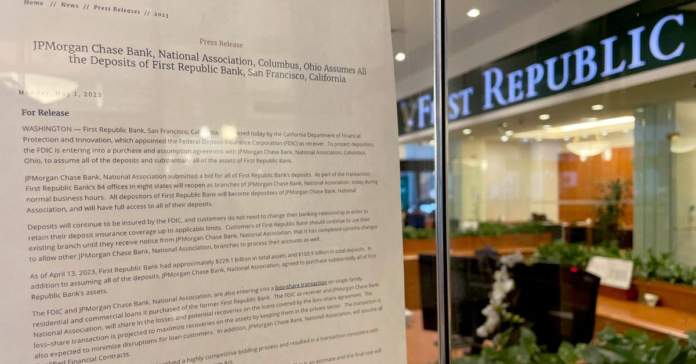WASHINGTON, May 1 (Reuters) – A key U.S. banking regulator on Monday laid out a range of options for reforming the federal deposit insurance system and concluded that significantly increasing the backstop for bank accounts used for business purposes was the “most promising.”
In the wake of March’s lightning-fast bank failures, expanding coverage for accounts used to cover payroll, invoices and other large business transactions has emerged as the Federal Deposit Insurance Corp’s preferred route for balancing financial stability and depositor protection, relative to its cost.
In order to effect any change to the government deposit protection scheme that has largely remained intact since its debut in the Great Depression in the 1930s, Congress would need to write a new statute describing what types of accounts would receive any additional coverage, FDIC officials said during a briefing with reporters.
The 76-page report also considered backstopping all accounts no matter what the amount, an option that would do the most to prevent bank runs, the report said, but would also have significant implications for market disruptions and could increase bank risk-taking.
Keeping the current system, where coverage is limited to $250,000 per-person per-bank, was the third option considered. While it would entail the least market disruption, it “fails to address the financial stability challenges” of large concentrations of uninsured deposits, the report said.
FDIC Chair Martin Gruenberg asked staff to undertake an analysis and review of options for reform of the deposit insurance system after the collapse of Silicon Valley Bank and Signature Bank in March, when regulators ended up backstopping all deposits to prevent contagion to the banking system.
Deposits at First Republic Bank, which was seized by regulators on Monday and sold to JPMorgan Chase & Co (JPM.N), did not require any formal government backstop, though the FDIC said the transaction would cost it $13 billion, on top of the $22.5 billion hit is has already taken from the SVB and Signature Bank failures.
The FDIC’s deposit insurance fund helps to fulfill the agency’s guarantee of bank deposits up to $250,000 per person. In the event an insured bank fails, the FDIC uses the deposit insurance fund to pay back customers who maintained accounts under the limit.
That $250,000 limit was enshrined in law by the 2010 Dodd-Frank reform law passed following the 2008 financial crisis, upped from what was before a $100,000 cap.
But following the collapse of SVB and Signature, there have been calls for a rethink.
U.S. Federal Reserve Chair Jerome Powell told Republican lawmakers in March that Congress should re-evaluate limits on the size of federally insured bank deposits.
Democratic Senator Elizabeth Warren told CBS’s “Face The Nation” in March that lifting the cap would be “a good move,” and Republican Senator Mike Rounds has questioned whether the $250,000 limit is still appropriate.
AN EXPLICIT GUARANTEE
Those in favor of getting rid of the cap argue that the government’s full backstop of SVB and Signature deposits already signals an implicit guarantee of all bank deposits.
Eliminating the cap altogether could be expensive and could end up undermining financial stability, the report said, because banks might take greater risks if their deposit bases are considered more stable.
Any changes would need legislation from a deeply divided Congress. The Republican House Freedom Caucus said in a March statement that its members would oppose any universal federal guarantee on bank deposits above the current $250,000 limit.
Reporting by Hannah Lang and Ann Saphir in Washington; Editing by Andrea Ricci and Nick Zieminski
Our Standards: The Thomson Reuters Trust Principles.




